The levels of price volatility in Indian stocks means traders and investors don't need to hold positions for long to make a profitable return. Covid 19, political uncertainty and the global economy's shift to ecologically sensitive business practices has led to whip-sawing price action in many stocks. Buying low and selling high, or vice-versa is the basic rule of trading; however, in Indian stocks, the answer to whether the correct decision has been made can be shared in next to no time.
YOUR CAPITAL IS AT RISK
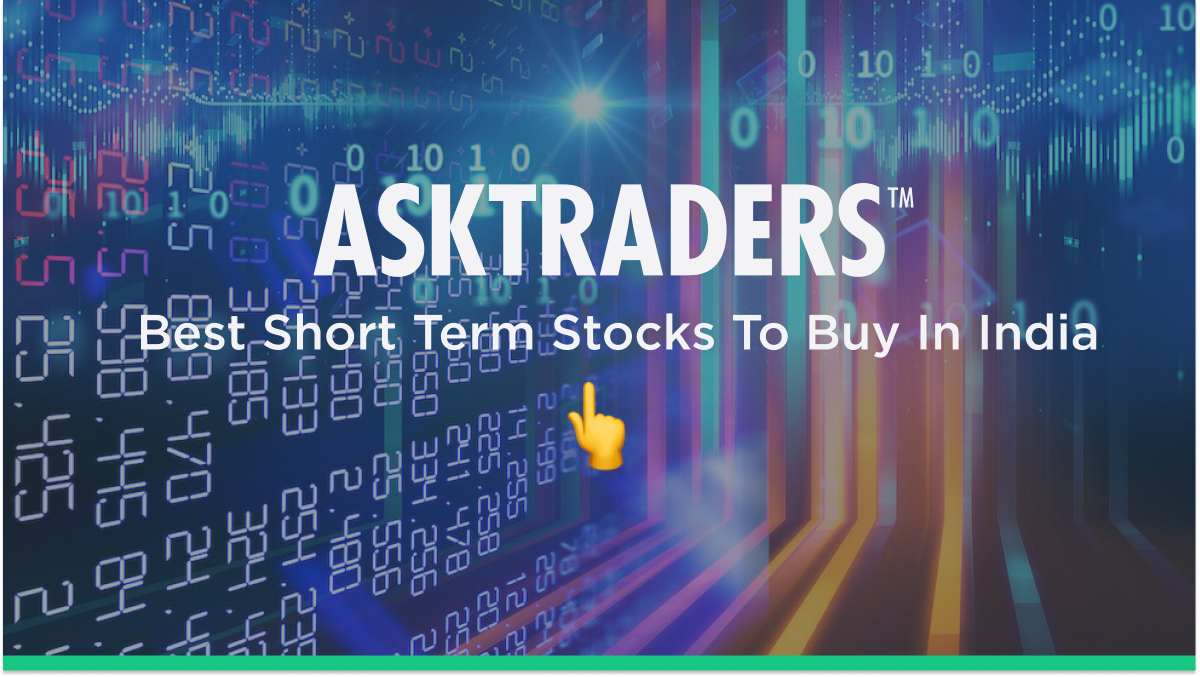
Recent news events have added extra noise to a situation where valuations already vary widely. The Indian elephant in the room is that pinpointing just how far the India success story can go is a tough call. Growth looks sure to continue, and according to the United Nations, India is due to become the most populous nation in the world by 2022. The country is also packed with tech-heavy industries of the future. Read on to learn more about the best short term stocks India has to offer.
India's Nifty 50 index of the largest stocks listed in the country has since March 2020 increased in value by an eye-watering 130%, but some stocks have outperformed the index over the same time frame. These include ‘local' Indian listed stocks and a range of well-known multinationals which have exposure to one of the world's most exciting economies.
Nifty 50 Stock Index Continues Its Upwards Trend
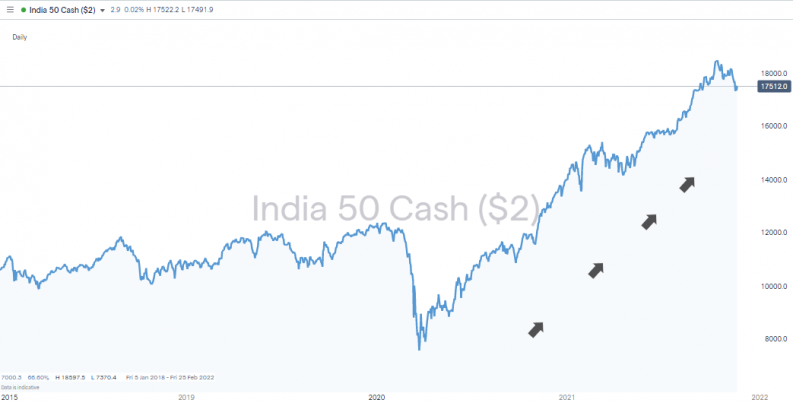
Source: IG
This review of the best short-term stocks to buy in India will share the tips insiders use to optimise returns. Identifying the right short-term investment opportunities involves using fundamental analysis to find the right target and technical analysis to optimise trade entry points. All trading can be a roller-coaster ride, so investors need to be aware of their appetite for risk, but those looking to scale up the risk-return on their trading can do worse than consider India stocks.
Table of contents
HDFC Bank Ltd
HDFC Bank Ltd is India's largest private bank by assets and market capitalisation. It's the third-largest company on the Indian stock exchange and being in the banking sector, HDFC stock is associated with relatively modest price volatility. Therefore, it can be a good entry-level stock for those looking to trade India stocks on a short-term basis.
It has a strong focus on the retail sector and issues loans and credit cards to its millions of customers. That means changes in forecasts of Indian economic growth can have a knock-on effect on the HDFC Bank share price. The firm has an innovative approach and exciting new products such as the digital payment products Payzapp and SmartBUY.
HDFC Bank Ltd Share Price 2020 -2021
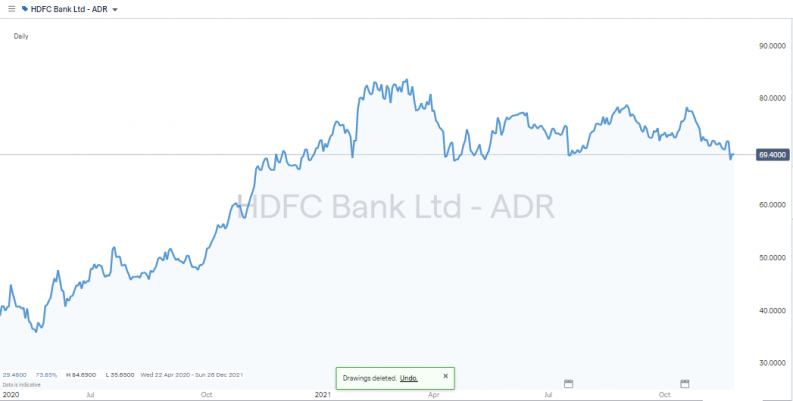
Source: IG
There is potential to make substantial gains from long positions in HDFC, and the bank's share price rose by +130% between the 19th of May 2020 and the 8th of February 2021.
YOUR CAPITAL IS AT RISK
Price Triggers for HDFC Bank
Through the second half of 2021, the HDFC stock price has consolidated, forming a sideways trading pattern. Company earnings announcements have been broadly in line with expectations but were followed by short-term spikes in the stock price.
HDFC Bank Ltd Share Price 2020 -2021 and Company Earnings Dates
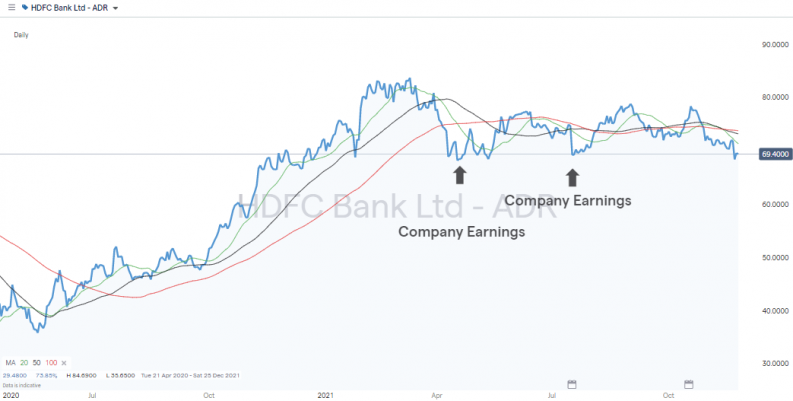
Source: IG
The R80 price level, which is providing resistance to further upward price moves, has been tested once already this year. Traders looking to buy the stock using technical signals can therefore wait for the year-to-date high of R84 to be broken – giving off a bullish trading signal. Alternatively, buy HDFC Bank stock at the bottom of the trading channel in the region of R65 before committing to the stock starting its next bull run.
HDFC Bank Ltd Share Price 2020 -2021 – Sideways Price Channel
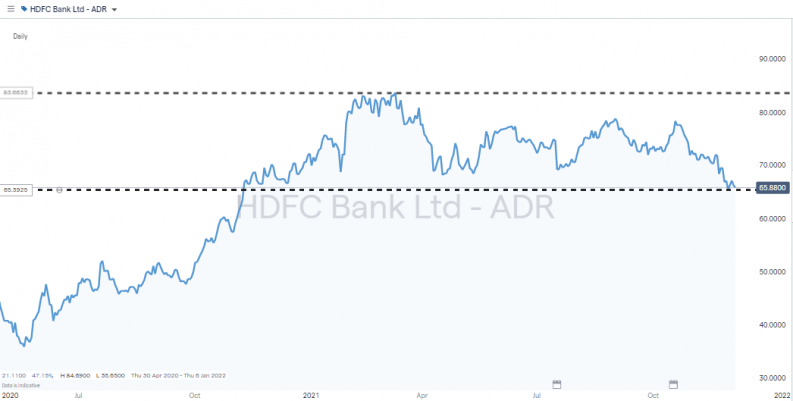
Source: IG
There is also the possibility of using CFDs to sell short HDFC Bank stock and profiting from price falling back from any highs in the region of R80 – R83.
HDFC Bank Ltd Fundamentals

Source: IG
- 2021 – Annual dividend amount per share: 0.37%
The firm is covered by a small number of brokers, but their stock forecasts are positive. The average rating is ‘Strong Buy'.
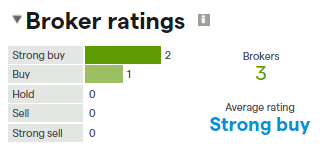
Source: IG
For the three months ended the 31st of March 2021, HDFC posted these positive returns:
- Interest income increased 5% to RS1.276trn
- Net interest income after loan loss provision increased 11% to RS529.45bn
- Net income increased 25% to RS325.98bn
- Net interest income after loan loss provision reflects Wholesale Banking segment increase of 39% to RS126.16bn
- Retail Banking segment increase of 4% to RS391.94bn
Source: IG
YOUR CAPITAL IS AT RISK
Infosys
One of the most widely traded stocks in the Indian market is the tech outsourcing giant Infosys. The Bangalore based firm has a global client base that includes Goldman Sachs, and it has operations spread across more than 50 countries. It has been operating for more than 40 years, and with a market cap in the region of $95bn, the firm offers a safe route into a growth sector.
Infosys stock is so widely traded that the bid-offer spread, the difference between buy and sell prices is narrower than it is for more illiquid stocks. That can be a big plus point for traders actively trading Infosys.
Infosys Share Price – 2018 – 2021
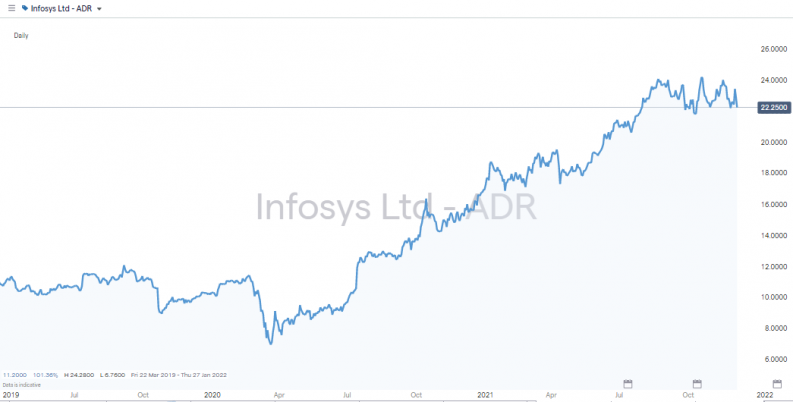
Source: IG
The post-Covid boom in tech and outsourcing stocks resulted in Infosys outperforming the Nifty 50 index. In fact, in the three months following March 2020, Infosys stock rose in value by more than 76%. It carried on growing to print a 2021 year-to-date high of 24.19 on the 20th of October, which represented a price increase of 239% from the lows of March 2020.
Since August 2021, the price of Infosys stock has consolidated, but there are still opportunities to trade short term moves off the support level at 21.85. In just seven days between the 11th and 18th of October, the stock rose 11% in value.
Infosys Share Price – 2021 – Price consolidation and dip-buying
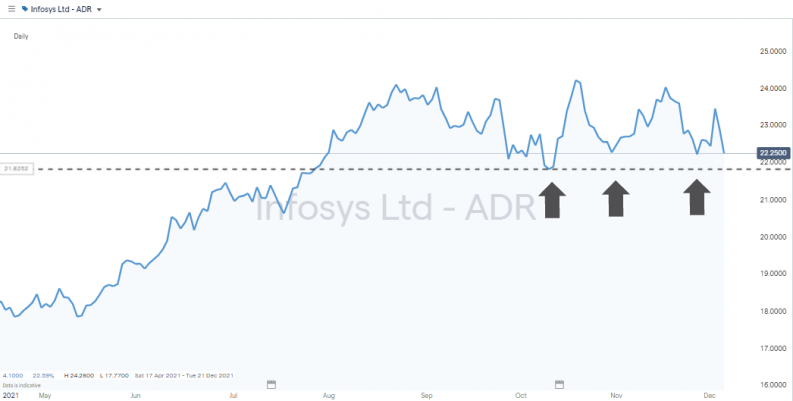
Source: IG
Price Triggers for Infosys
By Indian standards, it pays a healthy dividend, with the current yield being in the region of 1.78%, which means institutional investors are attracted to the stock. The greater the market flow, the better the bid-offer pricing and the more chances for short-term price moves.
Infosys – Balance Sheet
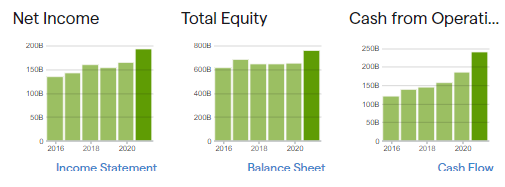
Source: IG
Highlights from the financial results for the six months up to the 30th of September 2021 include:
- Infosys Ltd ADR revenues increased 19% to RS574.98bn
- Net income increased 17% to RS106.16bn
- Revenues reflect Financial Services and Insurance (FS) segment increase of 23% to RS187.83bn
- Retail, Consumer packaged goods and Logistics (RCL) segment increase of 21% to RS85.05bn
- Manufacturing (MFG) segment increase of 32% to RS59.21bn
- North America segment increase of 21% to RS355.38bn
Source: IG
Infosys – Fundamentals

Source: IG
Infosys shares can be traded using local brokers or the ADR (American Depositary Receipt) version of the stock listed on the New York Stock Exchange and available to trade at offshore brokers. International brokers who offer CFD markets in Infosys stock facilitate leverage and short-selling based strategies.
YOUR CAPITAL IS AT RISK
Tata Motors Ltd
Automobile manufacturer, Tata Motors, offers a full suite of vehicles to a global client base. It has operations in the UK, South Africa, South Korea, China, Austria, Brazil, and Slovakia but is an Indian firm with its headquarters in Mumbai. It makes cars, SUVs, trucks, buses, and defence vehicles, and its electric vehicle production lines are of increasing importance.
Tata management has identified EVs as the next big thing in the world of motoring, and in the last quarter of 2020, half of all cars sold by Tata Motors were EVs. Tata Motors' overall share of electric vehicle sales in its 2020 reports stood at 43.3%. An official statement declared that ‘this booming market is poised for further growth in 2021 and beyond.'
There is fierce competition in the EV sector, and many of the valuations of companies are based on projections that are hard to make. There remain questions about the pace of the roll-out of the infrastructure needed to make EVs viable. If you then factor in the impact of Tesla Inc's maverick founder Elon Musk and it's easy to see why prices on EV stocks swing around so much.
Tata Motors could be a good buy for short-term traders. The value of EV manufacturers can be expected to sky-rocket once the tipping point in terms of charging infrastructure is reached. When that happens, the firm will switch from reporting on its ‘potential' and will instead be measuring dramatically increased income flows. With most equity valuation models being based on future revenue, changes to medium and long-term sales figures can impact the Tata share price.
Tata Motors Ltd – Monthly price chart 2005 – 2021
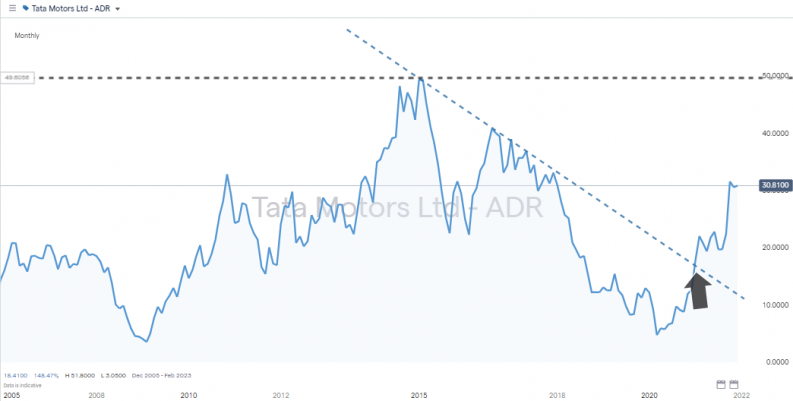
Source: IG
Between March 2020 and October 2021the price of Tata Motors stock rose by +569%. There is still some headroom left for the share price as the all-time-high of 51.73 is some way off the current price of 30.8.
Tata Motors Ltd – Fundamentals
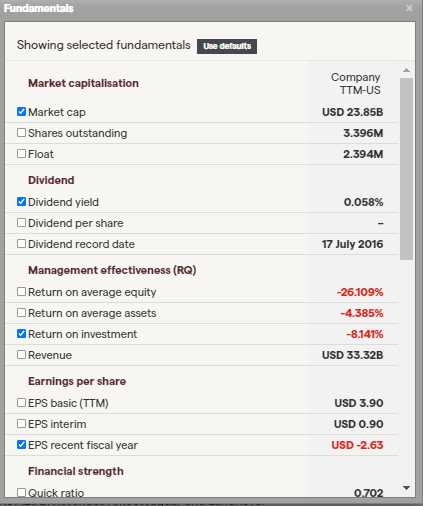
Source: IG
Tata Motors stock can be bought on the domestic exchange, or the internationally tradable ADR (American Depositary Receipt) listed on the New York Stock Exchange. It can be traded outright as part of a share dealing service or CFD format.
For the fiscal year ended the 31st of March 2021, Tata Motors Limited (ADR) reported that:
- Revenues decreased 4% to RS2.482trn
- Net loss increased 25% to RS142.7bn
- Revenues reflect Jaguar and Land Rover segment decrease of 7% to RS1.927trn
- Commercial Vehicle segment decrease of 8% to RS331.78bn
- Rest of World-segment decrease of 24% to RS351.66bn
- United States segment decrease of 10% to RS467.58bn
Source: IG
The breakout in December 2020 saw the Tata Motors stock price burst through the downward resistance trendline that dates back to 2015. The strength of that breakout and continued momentum suggests the path of least resistance remains upwards.
YOUR CAPITAL IS AT RISK
Microsoft India Ltd
The US-based tech giant has been a significant player in the Indian tech sector since 1990. Microsoft India Ltd offers cloud computing, consulting, security, AI and language services to domestic and global clients. The tech sector may be less volatile than it was in the Dot-Com bubble days. However, ground-breaking technologies are still tricky to value, and when different investors take different views on the fair value of Microsoft stock, price swings kick in.
Microsoft Daily Share Price – 2015 – 2021
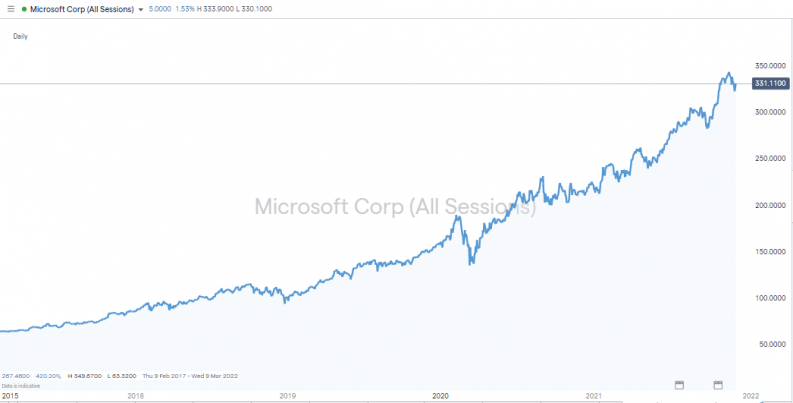
Source: IG
Putting a price on the exact potential of the cloud computing division is a particularly tricky call to make. The sector benefitted massively from Covid-19, triggering a move to remote working. Further strains of Covid and more lockdowns would reaffirm that shift, and Microsoft's clients appear to be already preparing for such eventualities. In the three months up to the end of September 2021, Microsoft's Intelligent Cloud segment increased by 31% to $16.96bn.
Microsoft has positioned three major data centres in India and developed relations with government and corporate partners. Cloud computing will be at the heart of India's digital transformation and a key driver of MSFT future share price growth.
Microsoft – Fundamentals

Source: IG
With such a high-profile role in the stock market, it's little surprise that 42 different analysts cover the stock. Only three out of that group tip the stock as a ‘Hold', with the remainder marking the stock down as a ‘Buy' or ‘Strong Buy'.
Microsoft – Broker Ratings
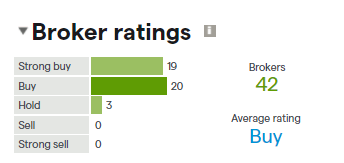
Source: IG
Fans of Microsoft stock have done well out of buying the dips for many years, and those dips and subsequent rallies keep on coming.
Microsoft Daily Share Price – 2015 – 2021 – with supporting trend line
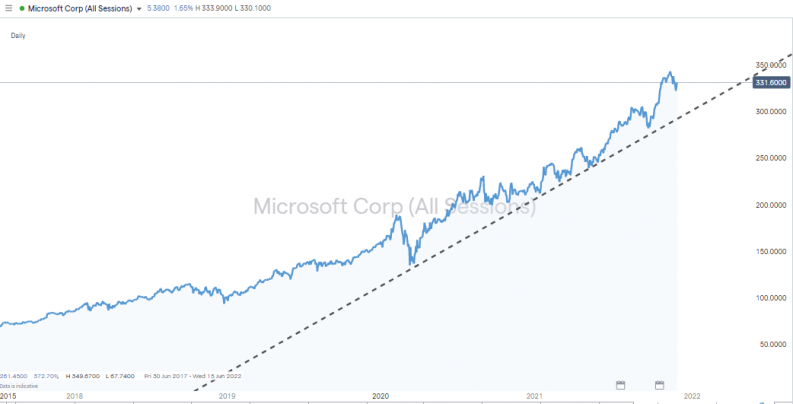
Source: IG
Highlights from the financial results for the three months up to the 30th of September 2021 include:
- Microsoft Corporation revenues increased 22% to $45.32bn
- Net income increased 48% to $20.51bn
- Revenues reflect Intelligent Cloud segment increase of 31% to $16.96bn
- Productivity and Business Processes segment increase of 22%to $15.04bn
- Personal Computing segment increase of 12%to $13.31bn
- Other countries segment increased 24% to $22.49bn
- United States segment increase of 20% to $22.83bn
Source: IG
YOUR CAPITAL IS AT RISK
Reliance Industries Ltd
Reliance Industries stock offers a way to gain broad exposure to India's economy. The firm's own missions statement states, “What is good for India is good for Reliance” (source: Source: Reliance Industries Ltd). So those who are optimistic about India's growth prospects can tap into it by buying into Reliance.
The Mumbai-based firm operates a diverse range of businesses, including energy, petrochemicals, gas production, retail, telecoms, textiles, and media. It started as a textiles and polyester manufacturer, but its entrepreneurial and dynamic approach has enabled it to expand into other areas of the ever-changing Indian economy.
Reliance Industries Share Price – 2015 – 2021
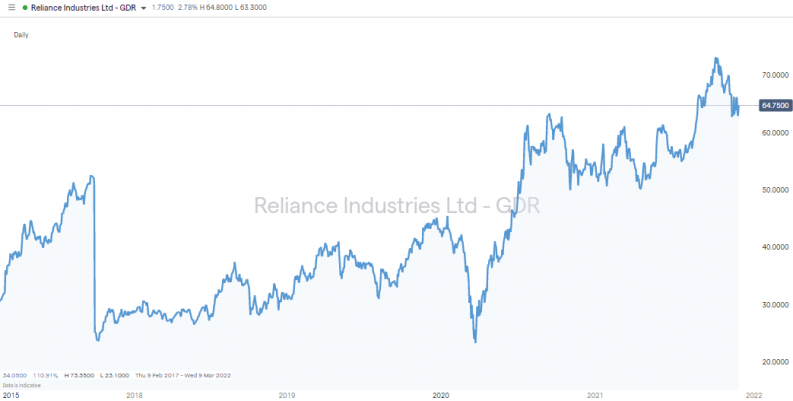
Source: IG
From a technical analysis perspective, the supporting trendline dating back to 2020 offers a chance to identify entry points on ‘long' positions. A break of the line would be a bearish indicator and a shorting opportunity.
Reliance Industries Daily Share Price – 2015 – 2021 – Supporting Trend Line
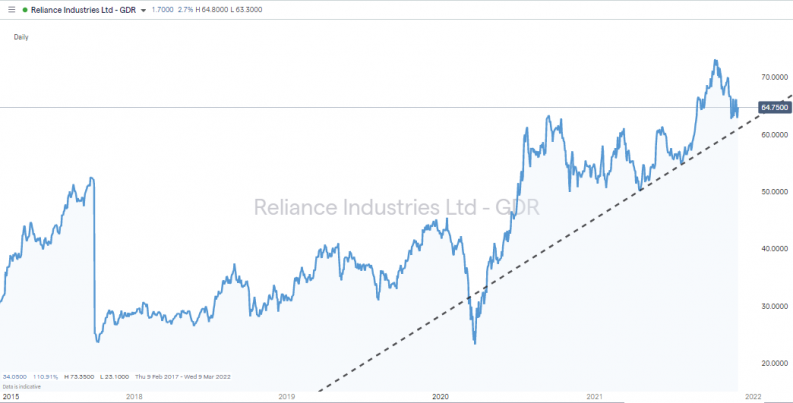
Source: IG
Reliance Industries has what it describes as a “superior credit profile” (source: Reliance Industries Ltd) and relations with more than 100 banks and financial institutions. That strong foundation is used as a base from which to develop new innovative business lines. These currently include projects in growth sectors.
The firm has “committed resources and ideas to a digital revolution, created world-class manufacturing assets that produce clean fuels and materials of the future and built a consumer-focused, integrated retail ecosystem. We have also joined forces with the best in the world to bring the best of the world to India.” Source: RIL
Reliance Industries Monthly Share Price – 2015 – 2021 – Breakout of sideways channel
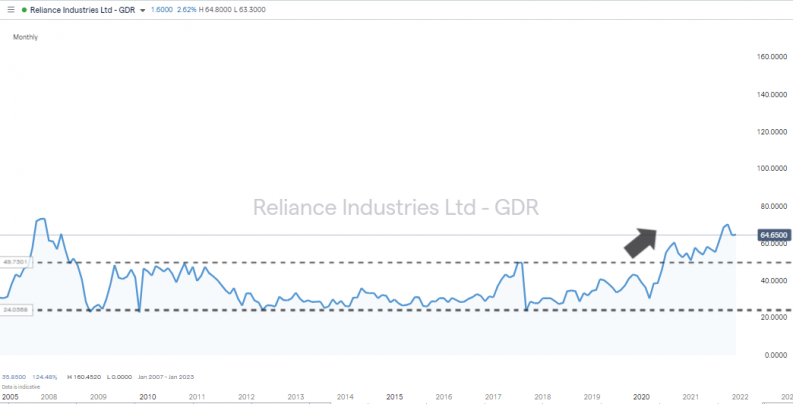
Source: IG
The breakout of the 2010 – 2020 sideways trading range has signalled the possibility of further upward price moves. This has also introduced the idea that the Reliance Industries share price could challenge the all-time price high of 81.25 recorded in January 2008.
Reliance Industries is a Fortune 500 company, and its shares can be bought on the domestic exchange or in GDR (Global Depositary Receipt) form through offshore brokers.
YOUR CAPITAL IS AT RISK
HOW TO BUY STOCKS IN INDIA
Most of the workload associated with picking short-term winners must be carried out before trading. Successful strategy building incorporates identifying targets, also trade entry and exit points. Other factors relating to the mechanics of the trading process need to be considered as they can also influence returns.
Portfolio Risk Management
The above shortlist of the best short-term stocks to buy in India is comprised of companies in a wide range of industrial sectors. The principle of investing in different areas of the Indian economy to diversify risk and smooth out returns applies to short-term trading as much as it does to long-term investing.
That being said, short-term stock buying typically attracts those with a greater risk appetite who specialise in finding volatile sectors to trade. If the booming India Tech sector is just too much to resist and the target of most of your capital, then taking small positions in a greater number of stocks also mitigates against single stock risk.
Trading small can take the emotion out of investing. That is a top tip for beginners. Trading portfolios that carry excessive risk can lead to traders making rash decisions rather than riding out market turbulence. It's also worth remembering that investing in any financial product market should be limited to the amounts of money you can afford to lose. That rule applies even more to speculative strategies.
Operational Risk
Big international brokers offer an online trading experience that takes powerful trading software and presents it to clients in an extremely user-friendly way. It's possible to trade from desktop or mobile devices so short-term trades can be monitored around the clock. The functionality of the trading dashboards and the markets offered, and terms and conditions can vary from broker to broker and trying a few out can help newbies make a good choice. Of equal importance is the need to ensure a broker can be trusted. Listed below are five simple steps to ensure you don't make any costly slip-ups when putting on trades.
1. Choose a Broker
The crucial factor to consider when choosing a broker is the security of your funds. Scammers operate in the market and setting up an online brokerage account requires sending money to a third party. One reliable guideline is to ensure that the broker you select is regulated by a tier-1 authority, such as one of the below:
- The Monetary Authority of India (MAS)
- The Financial Conduct Authority (FCA)
- The Australian Securities and Investments Commission (ASIC)
- The U.S. Securities and Exchange Commission (SEC)
- Cyprus Securities and Exchange Commission (CySEC)
- Securities and Exchange Board of India (SEBI)
2. Open and Fund an Account
An account with a global online broker is very similar to any other online bank account. Cash funds and traded stocks will sit in the same account. To ensure you, and only you, have control over the account, regulated brokers ask new clients to provide ID and work through a verification process known as ‘KYC' (Know Your Client). The process typically takes less than 10 minutes to complete and can be done using a desktop or handheld device.
Brokers regulated by Tier-1 authorities must also comply with Anti-Money Laundering (AML) laws. These are intended to clamp down on international crime but are worth mentioning as one of the rules is that funds have to be returned to the account from which they originally came. That cuts down the risk of scammers gaining access to your account and forwarding the money to another account.
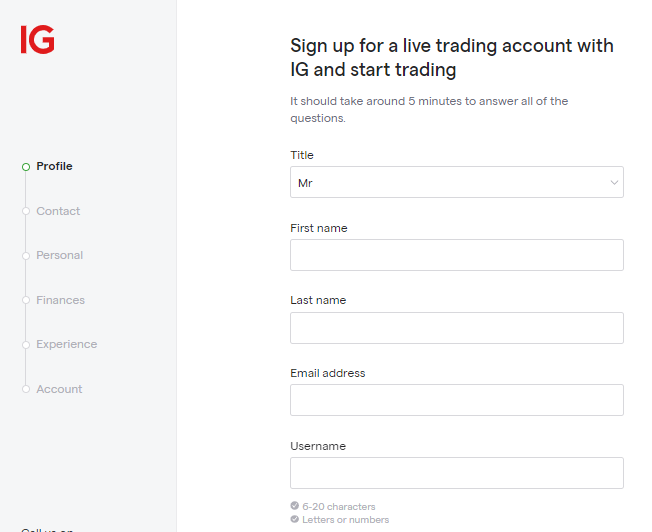
Source: IG
Most brokers offer a wide range of payment options and typically don't apply any charges on deposits. Still, it's worth checking if there are commissions on withdrawals and if your paying agent will add on any costs. Debit and credit cards remain popular options as payments using these can be processed immediately. Bank transfer and ePayment apps offer alternative ways to fund your account.
YOUR CAPITAL IS AT RISK
3. Open an Order Ticket and Set Your Position Size
Offshore broker platforms pride themselves on their user-friendly functionality. At IG, for example, it's possible to filter by country and pull up an extensive list of Indian stocks in which the broker offers markets. Stock picks in India are a hot topic, and the number of names available to trade is constantly increasing. As the above shortlist of the best short-term stocks to buy demonstrates, it's not only India listed sticks which offer exposure to the country.
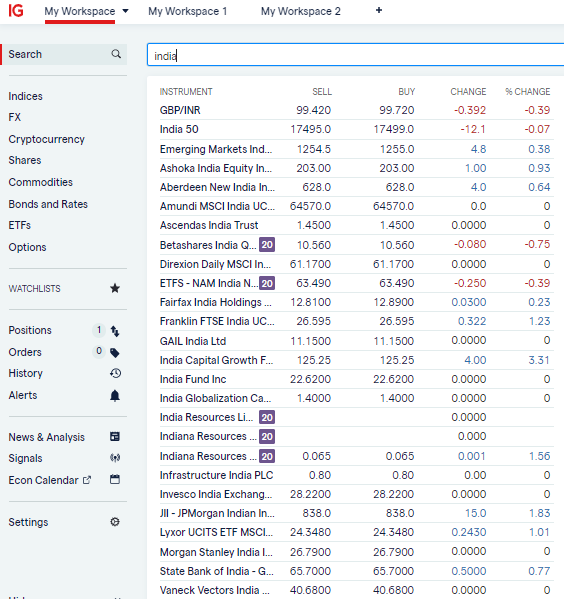
Source: IG
Clicking on any of those stocks will take you through to the dashboard for that stock. This site area will have price charts, financial statements, broker ratings and news reports. The trade-execution interface is where you can input the quantity of the stock you want to buy and clicking or tapping the ‘Buy' button will execute the trade. At that point, some of your cash pile will be converted into a stock position.
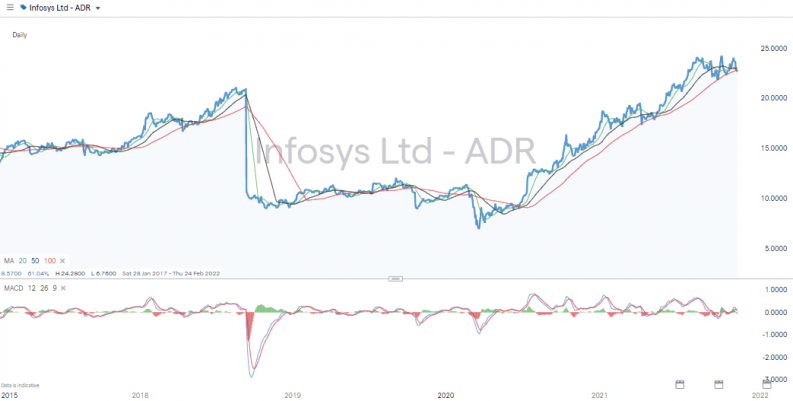
Source: IG
One important factor to consider is whether you buy the stocks outright or in CFD form. CFD's (Contract For Difference) involve the broker and the client entering an agreement that the price difference at the end of the trade will be resolved by one party paying the other. The client doesn't own the underlying stock but is exposed to price moves in its value.
Buy and hold investors tend to buy stocks outright as CFDs can be associated with additional costs over the long-term relating to financing the position. For short-term traders, the improved functionality of CFDs may be more important.
Traders who use CFDs can sell short or use leverage. These features scale-up risk-return but are popular with those applying short term strategies.
4. Set Your Stops & Limits
Other risk management tools are available that can help enhance returns and manage risk. Stop-loss instructions are orders built into the system which will automatically sell some or all of a position if the price goes in the wrong direction. Take profit orders work similarly but lock in gains if price reaches a certain level. Both instructions can be added and removed from trading positions at a client's discretion at any period of a trade's life.
Short-term price crashes and dramatic but temporary market moves can kick traders out of positions. As a result, some traders using short-term strategies need to decide whether to use stop-losses and take profits when major news announcements are due to be made.
5. Make Your Purchase
Whether you're using a desktop or mobile device, the final act of opening a new trade is simply a case of clicking or tapping ‘buy'. After that, the value of that position will be 100% dependant on the market price.
Accessing the Portfolio section of the platform will allow you to monitor the unrealised P&L (profit and loss) on any positions. It is also possible to set Price Alerts so that you are messaged if price reaches a certain level.
Visiting the Portfolio area of the platform after executing any trades allows traders to carry out one vital final check. Even experienced traders make ‘fat finger' errors and click ‘sell' instead of ‘buy' or input the wrong amount to trade. Such errors are best corrected immediately before price moves too far away from the trade entry point.
SUMMARY
India stocks tick a lot of boxes for short-term traders. The markets are highly liquid, which helps keep bid-offer spreads tight and ensures there is enough price volatility to generate trading opportunities.
Short-term investing can be a relatively high risk-return operation, especially if CFDs are used. It can also be time-consuming. Good brokers offer free to use Demo accounts to help those considering trading to try it out in a risk-free environment. They offer new traders a chance to become familiar with the mechanics of trading. Demo accounts are a great way to test out new strategies and trading ideas, and as they use live prices, it is possible to establish whether they are successful or not very quickly.
The impressive and sometimes sudden returns made by Indian stocks attract local and overseas investors looking to profit from short-term investments. They are drawn to the Indian economy's heavy weighting towards tech and the overall potential for economic growth.
Those who follow the simple guidelines around risk management and how to find a trusted broker will find that buying Indian stocks has never been safer. Trading in and out of positions using online platforms is easy to do and can be transacted from desktop and handheld devices.
Once the hard work of finding the best short term India stocks to buy has been completed, following the step-by-step guide will take you into the heart of the market. Then it's a matter of watching and waiting for the hoped-for returns to show up in your account.













